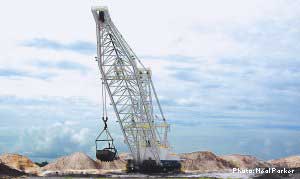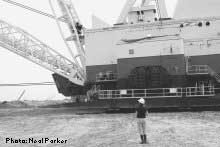 |
|

Digging for phosphate at Four Corners, the world's largest phosphate mine - so named because it is located at the crossroads of Hillsborough, Polk, Manatee and Hardee counties.
|
Phosphate at the Crossroads, part one of a two-part special report by Bay Soundings, traces the evolution of an industry with deep roots and massive land holdings in Florida, and the debate over environmental impacts on mining's next and, possibly, final frontier. Coming next issue: a look at the progress and pitfalls in mined land reclamation, and what the future holds.
Number 19 roars to life at the quiet crossroads of Hillsborough, Manatee, Polk and Hardee counties. The massive dragline is one of six earthmovers strip-mining for phosphate at Four Corners, the world's largest phosphate mine, located in the heart of Central Florida's Bone Valley region.
It's a 10-mile trek from the plant to the mine on dirt roads lined with inbound pipes pumping a slurry of phosphate rock, sand and clay known as "matrix" and outbound lines carrying sand tailings that will be used to back fill the gargantuan pits. Everything about Four Corners is big. Draglines with booms the length of football fields and weighing a staggering seven million pounds dig for matrix in mines that stretch as far as the eye can see. The 58,000-acre site yields about 7.5 million tons of ore a year, more than a quarter of the state's annual production.
Four Corners, like most other phosphate mines in Florida, is owned by Mosaic, a public company formed last year when agribusiness giant Cargill spun off its fertilizer holdings in a merger with IMC Agrico, then the world's largest phosphate mining company. The consolidated company is one of the few still standing in a shrinking industry marked by volatile markets, razor-thin margins and an insatiable thirst for capital.
For now, Florida phosphate is king, providing American farmers with 75 percent of their fertilizer needs and filling 25 percent of the world's supply. But times are changing. The richest phosphate reserves have been mined. Companies are being forced to work harder and smarter to make mining economically viable here. Phosphate's migration south in central Florida has met with fierce opposition from forces concerned about impacts to the Peace River, a critical source of drinking water for Southwest Florida and a tributary of Charlotte Harbor, one of the state's most productive estuaries.

Dwarfing all else, this phosphate dragline weighs a staggering 7 million pounds and sports a boom that is as long as a football field. |
Meanwhile, other questions loom large.
Like what to do with the more than 1 billion tons of phosphogypsum waste. Reuse of the phosphate processing by-product has sparked an intense debate because it contains low levels of radioactivity.
Or whether reclamation of former mine lands is actually working.
And Tampa Bay residents and regulators are still smarting from the fiasco at Piney Point, after Mulberry Phosphates abandoned its fertilizer plant and gypsum stack in 2001. Cleanup of the site, including more than a billion gallons of highly acidic wastewater stored in its stacks, has cost more than $160 million dollars so far and forced emergency discharges into Bishop Harbor.
Against this complex backdrop, two things are certain: phosphate is a non-renewable resource and Florida is running out. Some say reserves will be exhausted in as little as 30 years, possibly sooner, although technology may extend that window. What then? American farmers will have to rely on foreign sources like Morocco for phosphate, and food prices will almost certainly go up. What's particularly unsettling is that no one's talking about it - not yet.
Welcome to phosphate country.
|
|
|
Coming next issue: A look at the progress and pitfalls in mined land reclamation, and what the future holds. |
|
|

editors
Mary Kelley Hoppe
Victoria Parsons
design & graphics
McShane Communications
website development
Sherrie K. Henne
contributing writers
Eric Draper
local distribution
Albert Perrino
editorial advisory board
Suzanne Cooper
Tampa Bay Regional Planning Council
Dick Eckenrod
Tampa Bay Estuary Program
Frank Hearne
Mechanik, Nuccio, Bentley, Williams, Hearne & Wester, P.A.
Robin Lewis
Lewis Environmental Services
Don Sayre
Florida Power & Light
Francia Smith
Sawgrass Lake Park
Beth Bartos
Southwest Florida Water Management District
George Isiminger, PE
Port Manatee
Roger Tucker
Tampa Bay Regional Planning Council
Fred Webb
Hillsborough Community College
Allan Horton
Freelance Writer

administrative offices:
Bay Soundings
c/o Tampa Bay Regional Planning Council
4000 Gateway Centre Blvd.
Pinellas Park, FL 33782
Phone: 727.570.5151
Fax: 727.570.5118

electronic communications
editor@baysoundings.com
circulation@baysoundings.com
webmaster@baysoundings.com

|

